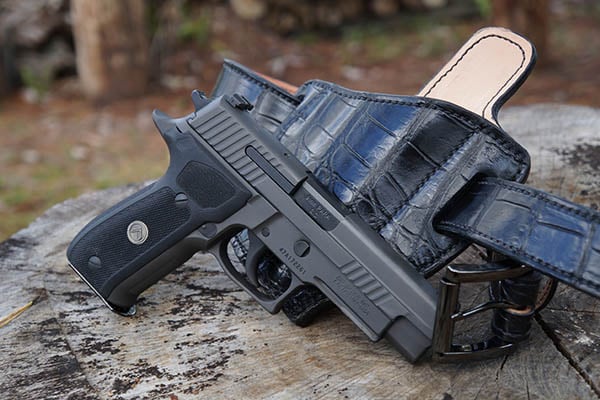
In the world of the true modern warrior, there are view names in the fields of military Special Operations, law enforcement and private contracting as highly regarded when it comes to the traditional double action combat pistol as SIG Sauer. Often heralded in the industry as being the “professional’s choice,” SIG Sauer continues to expand their catalogue of new and updated models using the direct feedback obtained by these real world users. In late 2015, SIG Sauer launched the new “Legion” series of firearms in the spirit of those elite operators around the world, while giving homage to the great Roman armies that are credited for personifying the “warrior mentality.”
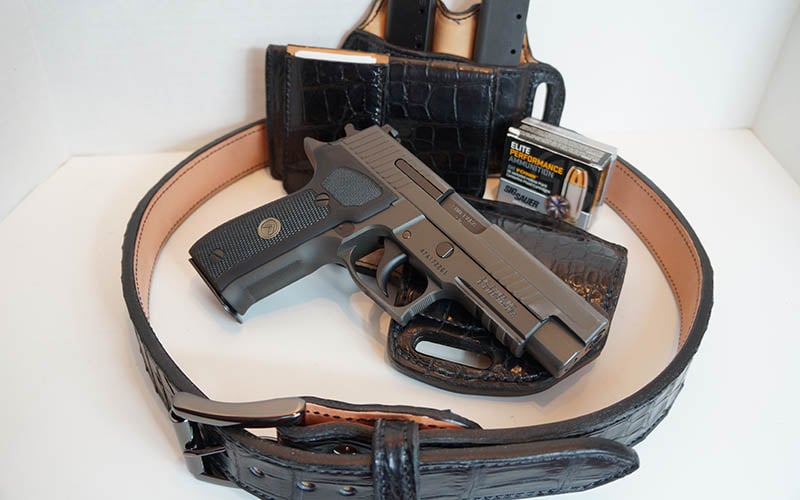
Currently, the Legion series consists of three pistol models (226, 226 SAO and 229) offered in three calibers (9mm, .357 SIG, and .40 S&W). For those of you not familiar with the standard versions of these pistols, the 226 has over the years become the yardstick to which most combat side arms are measured. The SAO models are basically the same pistol, but with a single action only trigger much like the classic 1911 in its action. The SIG 229, like the SAO, is based off the 226 but roughly 1 inch shorter in the barrel and grip to give shooters a slightly more compact 226. For my review, I choose to look at the mainstay of SIG’s combat handguns; the SIG Sauer Legion 226 chambered in NATO 9×19 aka 9mm.
First Look
When the SIG Legion 226 arrived at my local gun shop, Second Amendment Guns & Range, I opened up the relatively plain SIG box and inspected the contents. The pistol included three 15 round magazines and the usual stack of lawyer-proof instructions, warnings and brochures. Afterwards, I broke the pistol down and wiped the pistol’s barrel free of packing oil before hitting the range. This first trip onto the range was mainly to function test the pistol and begin its break in period with the first 50 rounds of SIG Elite Performance ammunition. I was assisted in quickly test firing the SIG by Reggie Jones, a security contractor buddy of mine who worked at the range part time. The initial shooting session went well, but as always, entirely too fast to be more than just a tease for much more fun on ensuing range trips (More on this later).
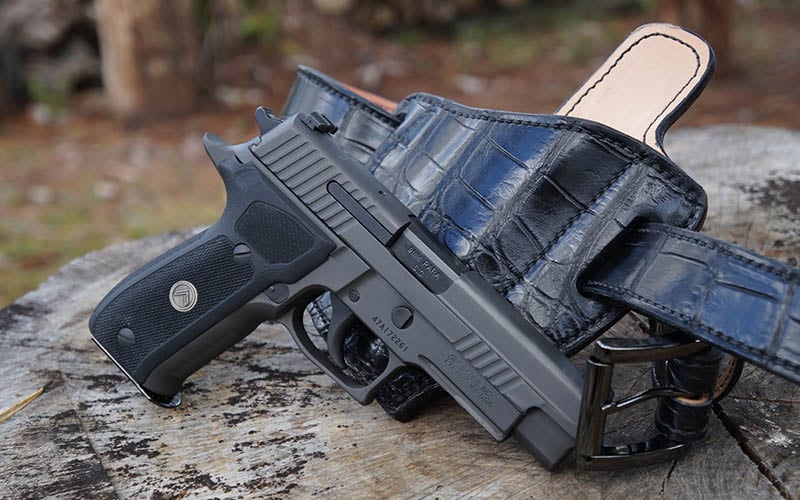
Once off the range, I again broke the pistol down and took time to take a closer overall look. Since 2001, I have probably shot well over a dozen of the current 24 versions of the model 226 to date between attending SWAT and CQB schools, Range Days at SHOT SHOW and doing various reviews. What stood out to me about this Legion series is that it was not just another tweaked standard 226 with a new model name slapped on it. Instead, the Legion 226 appeared to be redesigned from the ground up using the best parts of 226 models that came before it.
When holding the SIG Legion 226, the grip felt higher in line with the barrel via a deeper undercut in the trigger guard. The web of my hand seated tightly up to a reduced and beautifully contoured beaver tail that fit into my hand like a glove. The more aggressive checkering with the Legion pistol offered a much more secure hold than previous models. The new Legion grips were a nice departure from standard plastic or wood panels. Constructed from G10 material, these two piece grips offered a firm purchase on the pistol regardless if the gun was wet or if the shooter was wearing gloves. To top off the grips with a clean and professional look, a Legion medallion was embedded on each side. From this grip, I could easily reach the reduced slide release and de-cock lever to reduce snagging when carried concealed. The entire frame and slide were finished in SIG’s new proprietary Legion gray PVD coating to provide the metal protection from the harsh environments elite operators tend to regularly tread.

SIG SAUER P226 Legion Pistol
$1,299.99
Price accurate at time of writing
- Action: Semi-Automatic
- Caliber: 9mm Luger
- Barrel length: 4.4"
- Capacity: 15rd
- Weight: 33oz
Factory Specs
- Caliber: 9mm, .357 SIG, or .40 S&W
- Action Type: DA/SA
- Trigger Pull: 10 lbs. DA/ 4.4 lbs. SA
- Overall Length: 7.7″
- Overall Height: 5.5″
- Overall Width: 1.5″
- Barrel Length: 4.4″
- Weight w/Mag: 34 oz.
- Mag Capacity: 15 Rounds (9mm), 12 Rounds (.357 SIG), 12 Rounds (.40 S&W)
- Sights: X-Ray Day/Night Sights
Legion Carry
To find the right way to properly carry the Legion 226, I immediately started pondering long and hard on what sort of high quality rig I wanted to use for daily carry weeks before the Sig arrived for testing. About two weeks before testing began, I was attending a local outdoor trade show when I meet a fantastic holster maker, David Burns of Greystone Leather. Through our conversation at the show, I discovered David and I shared a lot of the same views on the industry and love of high quality gun rigs. On display in Greystone Leather’s booth, there were beautiful examples of traditional leather and exotic leather belts, holsters and magazine carriers. With products built from cow, shark, alligator and ostrich, I was absolutely mesmerized by the supple textures, high quality stitching and beautifully finished edges.
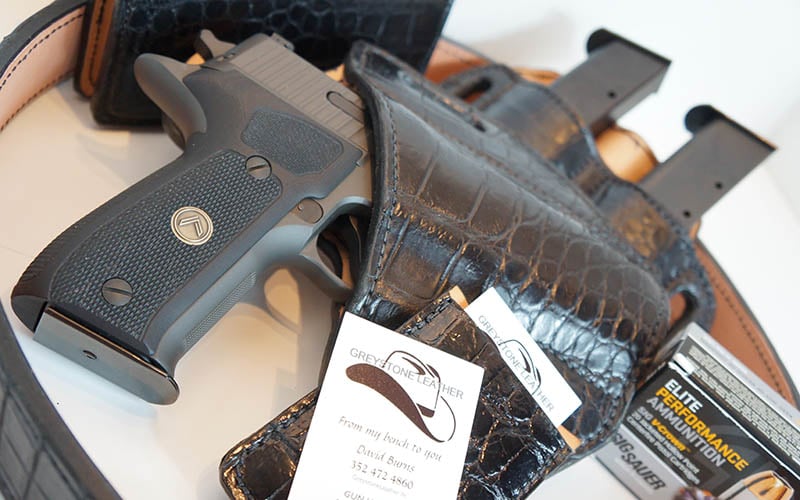
When I spoke to David about my opportunity to carry the Sig Legion 226 daily, he was more than happy to offer assistance with a sturdy leather gun rig. A few weeks later, what I received to try out with the SIG was much more than I had expected, it was a work of art! Looking over the new belt, holster and spare mag carrier, I was very impressed with the thick, rich American alligator leather finished in a deep black color which reflected the intricate grain and textures. My experience with thick leathers in the past has always been very stiff in the beginning and needing several weeks of break in time. What I discovered with the rig from Greystone Leather was the exact opposite. The belt was pliable and immediately comfortable from the first day I wore it with the matching holster and spare magazine carrier. I chose to go with an on the belt configuration or OWB due to fall arriving and I would be wearing a lot of untucked, longer style shirts and sweatshirts soon. If appearance would ever play a factor, this rig would be the one I would specially carry outside the waistband just because of how beautiful the leather was!
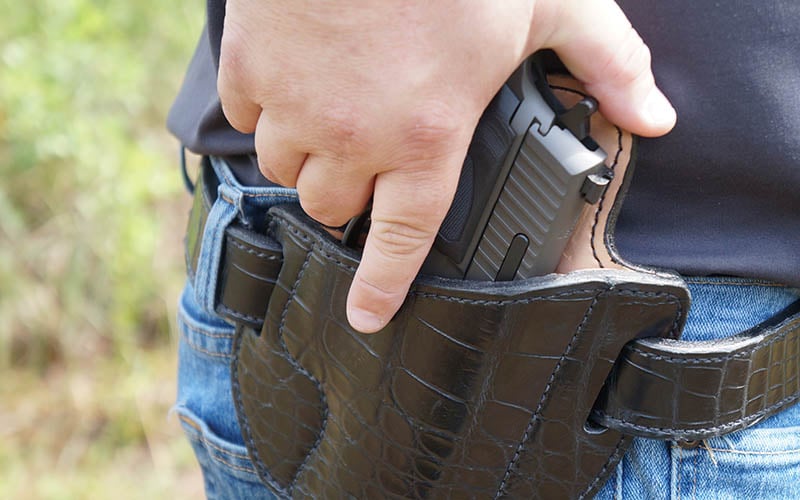
Despite the Legion 226 being a full size gun, it carried over the 120 day period extremely comfortable for over 12 hours a day. The open top design held the gun snug to the body while still allowing a very fast draw from the 3 and 4 o’ clock positions. The pistols redesigned and re-contoured beaver tail greatly helped reduce printing from other model 226 pistols I have carried. The spare magazine carrier fit well on the belt opposite of the holster and kept the magazine close enough to the body to not snag on clothing or arm chairs when seated, but exposed the top of the mag clearly enough to be acquired quickly without having to take my eyes off the target. The function was definitely as impressive as the appearance over the test period.
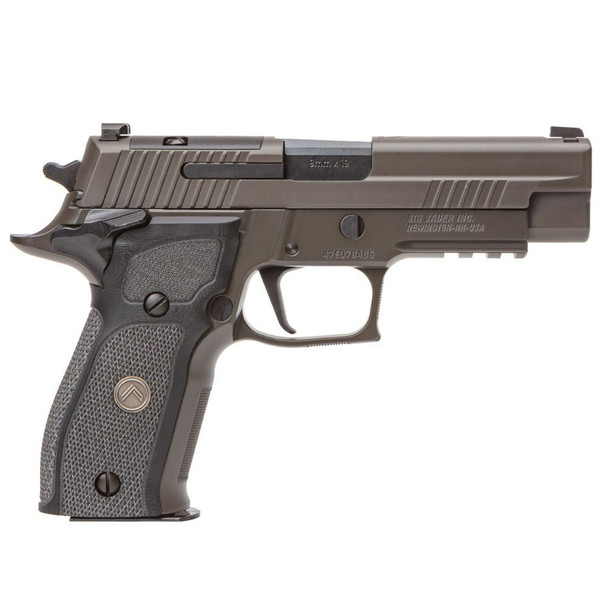
SIG SAUER P226 Legion SAO Pistol
$1,299.99
Price accurate at time of writing
- Action: Semi-Automatic
- Caliber: 9mm Luger
- Barrel length: 4.4"
- Capacity: 15rd
- Weight: 34oz
Legion Live Fire
Eager to get back on the range for some serious trigger time, I loaded up with 9mm ammunition from SIG Sauer, Hornady and newcomer to our testing line up, Fancy Brass Company. The SIG Elite Performance ammunition used for testing came in the form of SIG Full Metal Jacket 115 grain practice ammo and the new SIG V-Crown Jacketed Hollow Point 124 grain self-defense ammo. The Hornady Critical Defense 115 Grain Flex Tip Jacketed Hollow Point used often for concealed carry pistols. Having only used the Hornady ammo previous to the time spent with the SIG Legion 226, I was not only eager to find out more about the SIG ammo, but equally curious about the Fancy Brass Company’s 115 grain Full Metal Jacket ammo sent for testing as well. The main goal with using various brands of ammunition is to see how reliable the Legion 226 performs not only with SIG produced ammo designed specifically for the optimum performance of their pistols but to also see how the pistol handles other random rounds.
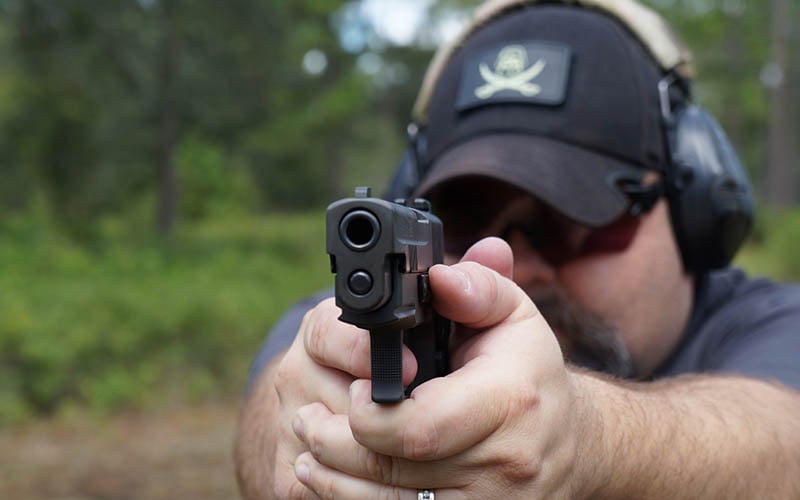
First up, I warmed up with the SIG FMJ 115 grain rounds. I loaded up all three 15 round magazines and went to work on a reduced sized torso target built from super tough AR500 from our friends at Steel Veteran Targets. Starting with slow fire head shots and moving to quick double taps into center mass at 15 yards, the Legion 226 ran like a sewing machine magazine after magazine. Switching to the V-Crown 124 grain JHP ammo, I felt like the pistol had a slight decrease in muzzle rise between shots but still struck the steel in the same area of the target as the lighter weight SIG ammo. After running 45 rounds of each, I decided to jumble up the JHP and FMJ rounds and blindly load both into magazines. As I shot the second round of testing, this time using 45 rounds of mismatched SIG ammo, I could not tell the difference between the hollow point and full metal jacket rounds. Again, the rounds all struck in the same area of the steel target as I moved back to 25 yards. Regardless of quick double taps or full magazine dumps, the Legion 226 kept rolling with both SIG Elite Performance choices in ammo.
Moving on to the Hornady Critical Defense Ammunition, I decided to move to the range’s smaller hanging steel targets at 15 yards. As I moved from target to target placing steady hits, the 115 grain Flex Tip JHP rounds rocked the steel hard! After running the SIG Elite Performance Ammunition, the Hornady ammo seemed to produce a slight bit more felt recoil but easily absorbed in the SIG Sauer Legion’s rigid metal frame. Limited to only 50 rounds, there were zero stoppages and plenty of power on target.
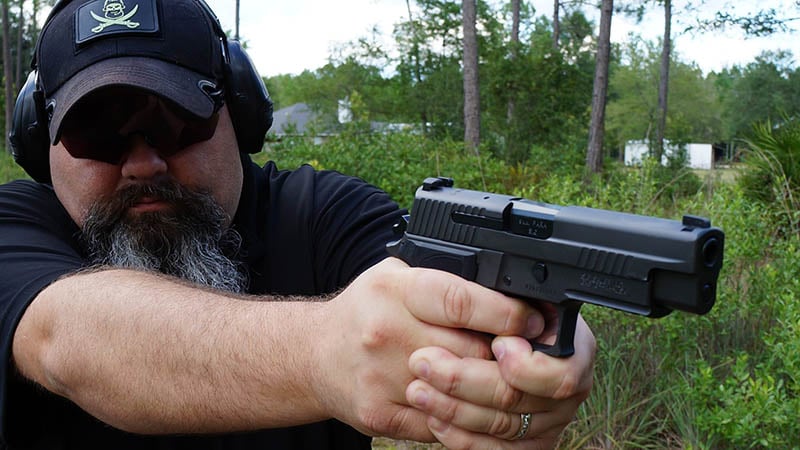
Finally, I came to the plastic ammo can full of 115 grain FMJ rounds from Fancy Brass Company. Having never seen this ammo before, I inspected it closely. Each round looked professional and clean as I filled my three magazines and made ready to send it all down range. Starting with quick double taps at 15 yards, I moved back to 20 yards and dumped a full magazine into the Steel Veteran Target. Recoil was very mild and controllable as I moved off the AR500 target and on to the hanging steel working across each of the 6 smaller targets. After a very quickly spent 100 rounds, any concerns I had about the new ammo were gone. With how well the rounds held on target, this may be our bulk round of choice in the near future.
I noticed the 226 was very quick to be able to obtain a proper sight alignment and sight picture using the pistol’s night sights SIG calls the “X-ray” sights. No, they will not help you see through a wall, but they are however very easy to use everywhere from bright day light to extreme low light. With their steel construction, I would not be worried about them banging into something during a deployment. The sights are vertical enough to catch very well on the belt during one handed magazine changes which I think are a vital part of any tactical training.
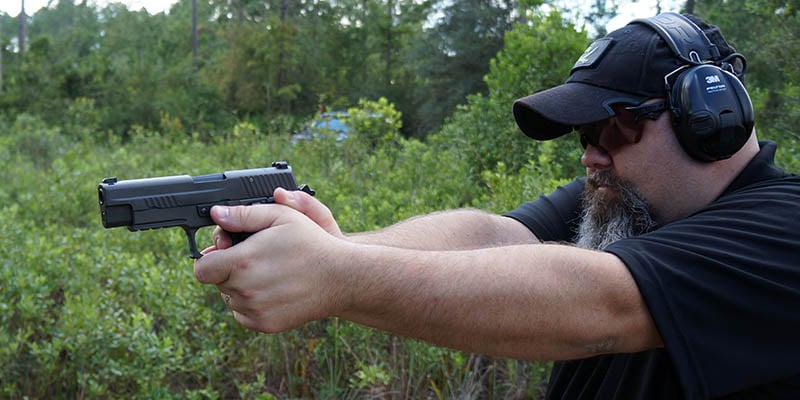
Shooting the 226 was very comfortable even over a two hour range trip. The solid steel guide rod and heavy spring absorbed recoil well and keep the muzzle rise to a minimal for quick follow up shots as well as long term durability of the gun overall. I noticed the pistol was very well balanced, even when using a Streamlight tactical flashlight mounted to the rail underneath the dustcover. The gun’s weight remained closer to the hand than the more popular polymer designs on the market, even after running the pistol dry of ammo.
The SRT or Short Reset Trigger combined with the highly polished internals made each trigger pull incredibly smooth and crisp with every shot. For those with shorter finger reach such as me, the 226 Legion’s SRT trigger is perhaps one of the easiest to shoot double action pistols on the market. If you have an older (non-Legion) model 226 without the SRT, I highly recommend getting in touch with Sig Sauer in regards to how to have one of these triggers installed in your gun.
Overall, the Legion 226 was definitely a pleasure to test during multiple trips to the range and use as my daily carry. My only complaint with the Legion upgrades came with the low profile controls. While I had no problem de-cocking the pistol, I did have difficulty releasing the slide stop on the move during drills. I will say it’s never recommended to use the slide stop as a slide release by most companies; it is a nice option in a rush. The slide stop was stiff and offered very little real estate to apply pressure when my thumb without breaking from a master grip. By properly using the sling shot method in pulling back the slide and releasing, the pistol chambered the fresh magazine crisp and clean, ready for action.
Final Thoughts
As fun as the Legion 226 pistol is to shoot, what SIG Sauer has accomplished with this series is much bigger than a good looking and great shooting gun. SIG Sauer is selling a lifestyle. Much like the American motorcycle icon, Harley Davidson, the Legion series has drawn people to a multi-product universe that can only be unlocked by purchasing the featured item. Over the past 50 years, people have spent just as much money on Harley related shirts, hats, helmets, jackets, etc. Speaking as a well experienced Harley lifestyle owner, I can attest to a period in life where my wife and I would have to purchase anything Harley from every shop visited while traveling. Once a shooter purchases a SIG Sauer Legion series pistol, they can either fill out a form included in the gun box or call SIG customer service and give them the serial number. In return, they are shipped a complimentary custom Thermo-Mold Legion series case custom-fit for your specific gun as well a challenge coin matched to your model pistol. On top of receiving your new pistol case, you are given an exclusive access code for member only Legion branded products such as hats, shirts, holsters, and even cigar humidors!
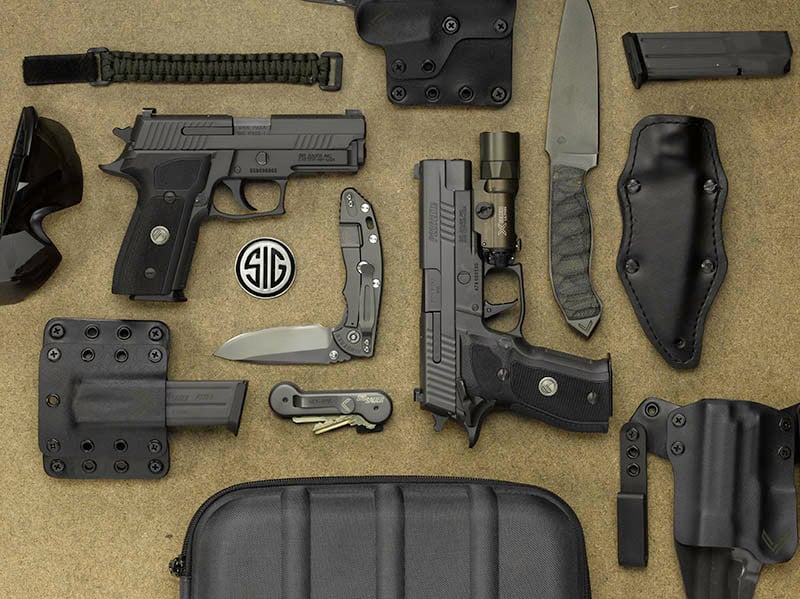
What will often be brought up in every review is the cost of admission to what some writers have dubbed the Legion series as the “cool kid club.” The MSRP for the Legion 226 is around $1350 and can be found in most stores for roughly $100 less. While most of the other versions of the model SIG 226 such as the Elite and Tac Ops run between $1100 and $1200, I don’t see where the usual voiced complaint of the Legion series pistols pricing by some reviewers. Given the redesign and performance of a highly reliable handgun, readers must keep in mind that most top end performing firearms command a much higher price tag.
Recently, I have even seen mocked up reviews of 226 clone pistols from Turkey being dunked into mud and sand to show it can withstand even more torture than its Sig counterpart, hoping to steal sales away from the much more expensive gun. What they don’t tell you is the clones are built with much cheaper materials with looser tolerances which lead to a lot less accurate pistols. What’s the point in a firearm shooting after spending an hour in mud and water if you can’t hit what you’re trying to shoot? There is a reason SIG Sauer has the reputation of professionals, because of top quality and accuracy battle proven from Special Operations groups to law enforcement globally. Slanted videos and anti-SIG writers will not stop the success of the Legion series as it looks to only continue growing it’s “Legion of Followers” as time marches on. For now, I highly recommend anyone to shoot a SIG Sauer Legion 226 for themselves and discover what it’s like to shoot the pistol of choice for operators around the world.





Leave a Reply